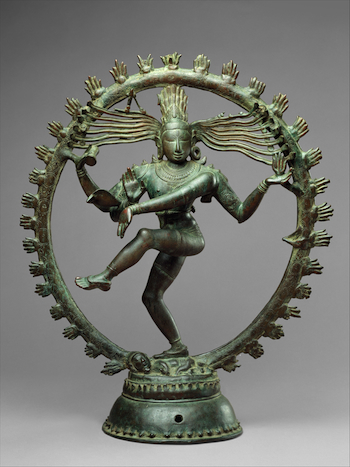Shiva

Shiva as Lord of the Dance (Nataraja), c. 11th century, Copper alloy, Chola period, 68.3 x 56.5 cm (The Metropolitan Museum of Art)
For my first blog post this week I decided to do it on the “Shiva as Lord of Dance” that was in the introduction video. I thought this piece was extremely unique and after reading and researching it I knew I was correct. This piece of art is depicted from the Hindu religion, which is older than the Buddhism religion, but the art from Hindu is quite newer than the Buddhism art. These two religions play a huge role in South Asia’s history of art because like medieval Europe, the art in south Asia was also primarily based on religion. What is really interesting about these specific pieces of art, is that most of the artists spent quite a bit of time in meditation which they experienced spiritual enhancement which inspired them to construct these magnificent sculptures. Shiva played a very important role in art during these times due to the significant role she played in religion in the Hindu people’s lives. Sculptures of her are looked at with such awe by Hindu devotee’s because of how sacred these pieces are.
Historians struggle to get the message across that this piece is taken out of context because of a couple reasons. First off, this statue is considered sacred, but it was made to be touched, moved, and worshipped often and thus the reason for its size. Typically, when we think of sacred statues we think of these big pieces where groups gather around and bow or gather around to worship, but this specific piece is the exact opposite of that. Secondly, historians don’t quite know the exact location of where this piece is from because it was moved so often. According to smart history, “It is important to keep in mind that the bronze Shiva as Lord of the Dance(“Nataraja”—nata meaning dance or performance, and raja meaning king or lord), is a sacred object that has been taken out of its original context—in fact, we don’t even know where this particular sculpture was originally venerated.” This is mind blowing because it sits in the middle of other statues (non-movable) at the Metropolitan Museum of Art. It’s quite interesting that this is a piece that historians don’t know where it’s from exactly but has an exact spot in a museum with a description of where it is from.
Smart history link: https://smarthistory.org/shiva-as-lord-of-the-dance-nataraja/
Khalid, Farisa, and Farisa Khalid. “Shiva as Lord of the Dance (Nataraja).” Smarthistory, smarthistory.org/shiva-as-lord-of-the-dance-nataraja/.

Comments
Post a Comment